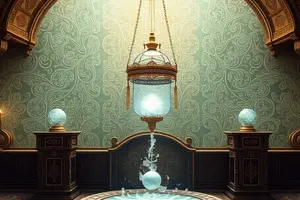Podcast
Questions and Answers
Explain the characteristics of an ideal gas and provide an example of a real gas.
Explain the characteristics of an ideal gas and provide an example of a real gas.
An ideal gas follows the gas laws at all pressure and temperatures, obeys the ideal gas equation PV=nRT, has negligible intermolecular interactions, and has very small particle volume. Oxygen, nitrogen, and air are considered real gases as they obey gas laws within certain temperature limits.
Define an ideal gas and explain why it is considered hypothetical.
Define an ideal gas and explain why it is considered hypothetical.
An ideal gas is a perfect gas that follows Boyle's law and Charles' law, with its characteristics equation obtained by the combination of these laws (PV=RT) at all pressure and temperature. It is considered hypothetical because there is no perfect gas in nature.
What are the differences between an ideal gas and a real gas?
What are the differences between an ideal gas and a real gas?
An ideal gas obeys gas laws under all pressure and temperature, follows the ideal gas equation PV=nRT, has negligible intermolecular interactions, and has very small particle volume, while a real gas obeys gas laws only under low pressure and temperature, does not obey the ideal gas equation, and has non-negligible particle volume compared to the total volume of gas.
Discuss the existence of ideal gases in nature.
Discuss the existence of ideal gases in nature.
Explain the conditions under which real gases are considered perfect gases.
Explain the conditions under which real gases are considered perfect gases.
Flashcards
Ideal Gas Characteristics
Ideal Gas Characteristics
Follows gas laws at all pressures/temperatures, obeys PV=nRT, negligible intermolecular interactions, very small particle volume.
Ideal Gas Definition
Ideal Gas Definition
A hypothetical gas that perfectly follows Boyle's and Charles' laws (PV=RT) at all pressures and temperatures.
Ideal vs. Real Gases
Ideal vs. Real Gases
Ideal gases obey gas laws under all conditions. Real gases only at low pressure and high temperature.
Real Gases as 'Perfect'
Real Gases as 'Perfect'
Signup and view all the flashcards
When Real Gases Act Ideal
When Real Gases Act Ideal
Signup and view all the flashcards




